Going to Seed
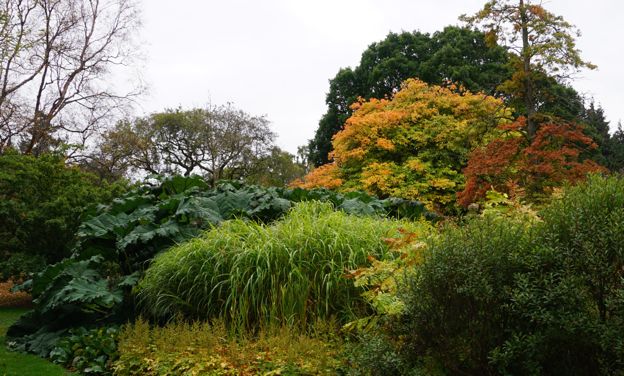
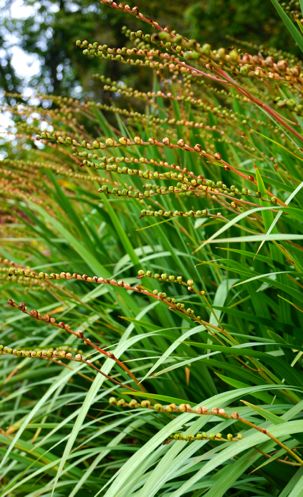
I love botanic gardens and have visited many, from Hong Kong to Madrid, and New York to Amsterdam. Botanic gardens, and their forebears, physick gardens, originated in the 1300’s to collect, study, and display plants. Many now offer design and education programs as well and I seem to learn something every time I wander through one. Visiting the Royal Botanic Garden in Edinburgh, Scotland (RBGE), last week, proved no exception.
It was a chilly day, but the gardens were filled with visitors of all ages and many nationalities. I strolled through the various display gardens, impressed by how beautifully maintained they were. Not a leaf was out of place, everything was perfectly pruned, and each flower and shrub bed was precisely edged. It takes a good deal of work to make an autumn garden look this good, so it was surprising to find that many of the perennials had not been cut back after they’d finished blooming: In fact, they’d gone to seed.
I first took notice when I walked by a stand of 1.5’ montbretia (this one was Crocosmia pottsii), a native of South African wetlands. The familiar bright scarlet flowers of late summer had long stopped blooming and had yielded to well shaped green seed capsules aligned tightly on red-tinged stems. They were suspended delicately above long, narrow, elegant leaves – subtle but eye-catching because they were planted in a large mass. I hadn’t realized that, in addition to bearing gorgeous flowers (orange, red, and pink varieties are also available) and attracting hummingbirds, montebretia’s seedheads are a great reason to grow these sun-loving perennials. Would that I had a sunny garden.
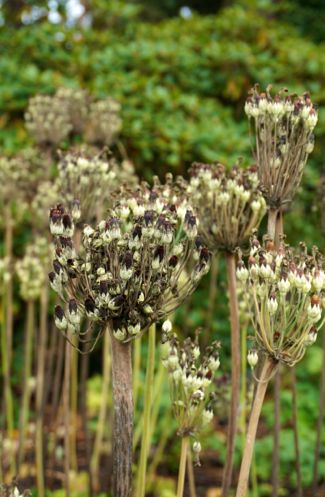
A little further on was an attractive group of black and white seedheads that looked almost, but not quite, like a species of onion. To read the accompanying label I guiltily crossed a lawn that looked like it had been recently combed. It seems these were not onions but primroses (Primula sikkimensis), cowslips as the British call them, which come from the spring-wet meadows of the Himalayas. They bear rounded clusters of small, fragrant buttery yellow or white flowers in the late spring on 1-3 foot stems, which is relatively tall for a primrose. They would be beautiful combined with bulbs and hellebores. The Himalayan primrose is supposedly easy to grow from seed. Even though primulae generally do not flourish in our hot summers, especially if they get dry, it may be interesting to give these a try if you can find them – and, of course, letting them go to seed so you can grow them again if they don’t survive our heat.

A story about a Scottish garden would be incomplete without something “thistly”. There were several thistles that had gone to seed, but an especially pretty one was the spiny berg thistle (Berkeya multijuga). The name alone was terrific. This plant is another South African native and its leaves grow in a circle: Think spiky bright green leaves growing in the form of a large rosette. Its flowers are bright yellow and daisy-like, so not the typical Scottish thistle flower, and it prefers to grow in dry hot sun with good drainage. Dried to a light brown, the architecture of the plant was especially strong, which was a good part of its appeal. They would look great in dried fall flower arrangements and, in fact, my hotel had used similar thistles in small tabletop arrangements.
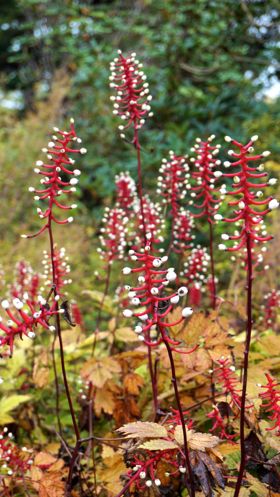
Around the corner in a shady wooded spot was a very colorful group of white berries clusteredon crimson stems that I could not take my eyes off. They belonged to white baneberry or doll’s eyes (Actaea pachypoda), a North American native that I have seen growing in small clumps in the Connecticut and Maine woods. They always catch my eye and here, grown in a substantial mass as part of a flower border, they are simply breathtaking. In summer, baneberry has attractive small white flowers that are look like a loose bottlebrush but the flowers are far less showy than the berries. A word of caution: I remember my 8th grade teacher emphatically impressing upon us that white berries are always poisonous and indeed, white baneberry is toxic.
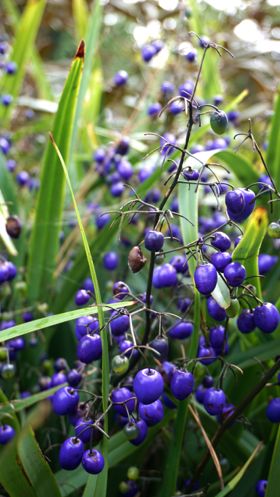
There were many other perennials that had gone to seed, including ligularia, astilbes, iris, and several I didn’t recognize. The one that stands out was the blue flax lily (Dianella tasmanica), an Australian native from the forests of Tasmania. If the name isn’t exotic enough, the cerulean blue berries, clustered on slender stalks amidst dark green strappy leaves, were visible from a long way off in that autumnal garden. Its flowers are small and blue as well, but nowhere near as striking as the berries. Apparently a variegated form is commercially available, but I can’t help thinking that white striped leaves would detract from that amazing color blue.
Moments after admiring the Dianella tasmanica (what a name!) I came across a large patch of tiny plants that would be sensational growing beside it. Only 2-3 inches tall, they had striped cobalt blue trumpets facing heavenward. They grew so closely together that from a distance they appeared to form a small floral carpet. Once again I found myself on that impeccable lawn reading the label, which told me that they are gentians (Gentiana ternifolia cangshan). There are over 1000 species and they grow on every continent but Antarctica and in all kinds of environments. While gentians are often blue, there are other colors as well. These beauties are a Chinese species that was collected in the early 1980’s on a joint Sino-British expedition (http://www.st-andrews.ac.uk/~gdk/stabg_new/poms/2011/may11pom.htm). They are to die for, as are the lighter blue ones that were planted near by. They hadn’t yet gone to seed, obviously, but I can’t help mentioning them because they were exceptional.
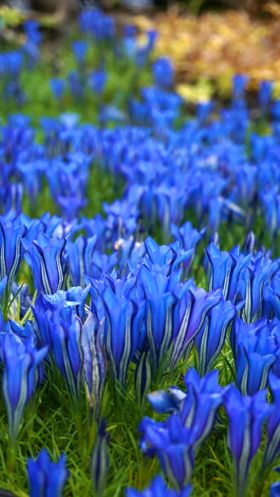
As I walked away from the Garden, having whiled away several hours, I kept thinking about how marvelous it was that these perennials had been permitted to go to seed in such a well-manicured landscape. The contrast between the maintained grounds and the slightly unruly seedheads made me think of the Dutch designer, Piet Oudolf. Oudolf, who is best known for his planting of New York’s Highline, famously prefers perennials that produce seedheads in the fall both because they are attractive and they provide food for birds. He has developed a garden style that is very natural looking, but is meticulously planned, planted and maintained. It seemed to me that, whether inspired by Oudolf or not, the ERBG’s approach is a more controlled means of achieving the same thing – permitting seeds heads to contribute to the splendor of the fall garden and providing food for wildlife in a disciplined planting style.
Either way, I concluded, that going to seed is a good thing.
